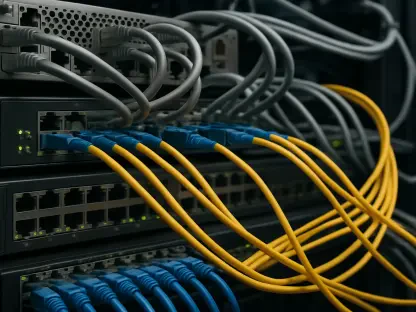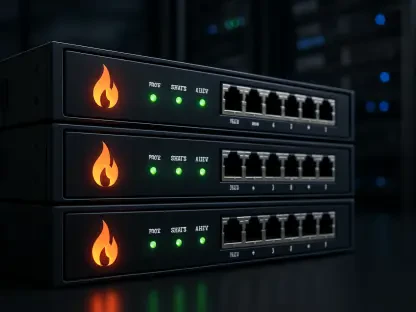In a technological landscape where artificial intelligence (AI) is reshaping industries at an unprecedented pace, the AI chip market, projected to exceed $90 billion in value, stands as a battleground for innovation and dominance. This high-stakes arena pits NVIDIA, the undisputed leader in AI graphics processing units (GPUs), against Broadcom, a formidable contender leveraging custom solutions to carve out its space. Their rivalry transcends mere competition for market share; it’s a defining struggle to shape the very foundation of AI infrastructure. As tech giants increasingly depend on advanced hardware to fuel complex AI applications, the outcome of this clash will influence everything from cloud computing to autonomous systems. The intensity of this contest is driving rapid advancements, challenging industry norms, and prompting hyperscale providers to rethink their reliance on single vendors. This dynamic promises to redefine how AI hardware evolves in response to growing demands for efficiency and power.
Market Dynamics and Growth
Stakes in a Booming Sector
The AI chip market’s explosive growth projection to over $90 billion underscores its critical role in the global tech ecosystem, positioning it as a cornerstone for future innovation across multiple sectors. This isn’t merely a corporate rivalry between NVIDIA and Broadcom; it’s a battle for control over the technology that powers transformative applications, from cloud services to self-driving vehicles. Every major industry is tethered to the capabilities of these chips, making the stakes extraordinarily high. NVIDIA has long held a dominant position with its GPUs, commanding a significant share of the market, while Broadcom is swiftly gaining ground with tailored solutions that address specific needs. The financial and strategic importance of this sector cannot be overstated, as billions are poured into research and manufacturing to stay ahead. This competition is not just about who leads today but about who will define the technological trajectory for years to come, impacting global economic and innovation landscapes.
Beyond the immediate financial implications, the rivalry in this booming sector is reshaping strategic alliances and investment priorities among tech giants. Hyperscale cloud providers, who are major consumers of AI chips, are keenly observing this contest, as their operational efficiency hinges on accessing cutting-edge hardware. The battle between NVIDIA and Broadcom is pushing the boundaries of what’s possible in semiconductor design, with each company striving to outpace the other in delivering solutions that meet escalating demands. Additionally, the capital-intensive nature of chip development means that only players with substantial resources can sustain the race, potentially widening the gap between industry leaders and smaller contenders. This dynamic is creating a ripple effect, influencing not just the primary competitors but also suppliers, partners, and end-users who depend on a steady stream of innovation to maintain their competitive edge in an AI-driven world.
Hyperscaler Influence
Hyperscale cloud providers such as Amazon, Google, and Microsoft are pivotal forces in steering the direction of the AI chip market, actively seeking to diversify their supply chains to avoid over-dependence on a single vendor like NVIDIA. These tech behemoths are not merely passive buyers; they are shaping the competitive landscape by designing their own chips and forging strategic partnerships with companies like Broadcom for customized hardware solutions. This push for diversification is a direct response to the risks of vendor lock-in, compelling NVIDIA to continuously innovate while offering Broadcom opportunities to expand its footprint with bespoke offerings. The influence of hyperscalers is evident in how they drive down costs through competitive bidding and demand rapid advancements tailored to their specific workloads. Their dual role as consumers and innovators is creating a more fragmented yet dynamic hardware ecosystem that challenges traditional market dominance.
The impact of hyperscaler influence extends to how pricing and development timelines are negotiated in the AI chip industry, placing additional pressure on leading players to adapt swiftly to client needs. By leveraging their substantial buying power, these companies are able to negotiate better terms, which in turn accelerates the pace of technological breakthroughs as suppliers vie for lucrative contracts. Broadcom benefits significantly from this trend, as its focus on energy-efficient, custom Application-Specific Integrated Circuits (ASICs) aligns well with the tailored demands of hyperscale data centers. Meanwhile, NVIDIA must balance maintaining its premium positioning with the need to offer competitive pricing to retain its stronghold. This ongoing tug-of-war between hyperscalers and chip manufacturers is fostering an environment where innovation is not just encouraged but required for survival, ultimately benefiting end-users with more advanced and cost-effective AI solutions.
Technological Shifts and Innovation
Specialization Over Generalization
A profound shift is underway in the AI chip industry, moving away from generic, one-size-fits-all hardware towards highly specialized silicon designed for distinct AI workloads, reflecting the unique strengths of NVIDIA and Broadcom. NVIDIA continues to dominate the realm of training AI models, where its GPUs deliver unparalleled raw computational power necessary for handling vast datasets and complex algorithms. In contrast, Broadcom is making significant inroads with its focus on inference and connectivity, crafting ASICs that optimize the deployment of trained models in real-world applications with greater efficiency. This duality in approach highlights a broader industry trend where the specific needs of AI processes are dictating hardware design, pushing companies to innovate in targeted ways. The result is a more nuanced market where different technologies coexist to address varied demands, paving the way for a new era of AI infrastructure that prioritizes precision over universality.
This emphasis on specialization is also a response to the evolving requirements of modern AI applications, which demand hardware that can handle specific tasks with maximum effectiveness rather than broad, general-purpose capabilities. For NVIDIA, this means continuously enhancing its GPU architectures to maintain leadership in high-intensity computing tasks, ensuring that training phases are executed with speed and accuracy. Broadcom, on the other hand, tailors its solutions to optimize inference at scale, reducing latency and power usage in data centers where AI models are applied continuously. This strategic divergence not only fuels competition but also complements the overall ecosystem, as end-users benefit from a spectrum of tools designed for different stages of AI development. As specialization becomes the norm, it challenges chipmakers to deepen their expertise in niche areas, ensuring that the next generation of AI systems is both powerful and purpose-built for efficiency.
Energy and Connectivity Challenges
Energy consumption stands as one of the most pressing challenges in the AI chip market, with data centers consuming vast amounts of power to sustain the intensive workloads required by modern AI applications, necessitating innovative solutions from both NVIDIA and Broadcom. The escalating energy demands of AI systems have placed sustainability at the forefront of industry concerns, prompting a reevaluation of how chips are designed and deployed. Broadcom’s ASICs are engineered with power efficiency in mind, offering a compelling advantage for hyperscale environments where operating costs and environmental impact are critical considerations. Meanwhile, NVIDIA’s high-performance GPUs, while unmatched in raw power, must contend with higher energy footprints, pushing the company to explore advancements in power management to complement its offerings. Addressing these energy challenges is not just a technical imperative but a competitive differentiator in a market increasingly focused on green technology.
Connectivity represents another critical bottleneck in the AI infrastructure landscape, as the rapid transfer of massive data volumes is essential for seamless operation, an area where Broadcom’s expertise provides a distinct edge. High-speed networking solutions, such as advanced Ethernet switch chips, are vital for ensuring that data flows efficiently within and between data centers, minimizing delays in AI processing. Broadcom’s focus on this aspect complements its energy-efficient designs, creating a holistic approach to data center needs that enhances overall system performance. NVIDIA, while primarily focused on compute power, must also ensure its hardware integrates effectively with networking frameworks to maintain its ecosystem’s appeal. Together, these companies are tackling the twin challenges of energy and connectivity, driving innovations that balance speed, efficiency, and sustainability to meet the rigorous demands of AI-driven environments.
Future Outlook and Industry Impacts
Trajectories of Competition
Looking ahead, the competitive trajectories of NVIDIA and Broadcom suggest a landscape where each maintains distinct yet overlapping strengths, with NVIDIA likely to retain its lead in AI model training while Broadcom expands its influence in tailored inference and networking solutions. NVIDIA’s robust ecosystem, built on powerful GPU architectures and integrated software platforms, positions it as the go-to choice for computationally intensive tasks, though it must navigate potential supply chain disruptions and client diversification efforts. Broadcom, with its rapid growth fueled by custom ASICs and strategic partnerships with tech giants, is carving out a significant niche in optimizing data center operations for efficiency and scale. Emerging opportunities in sectors like healthcare and automotive could further expand the market, offering new avenues for both companies to apply their technologies. However, persistent challenges such as capital costs and supply chain hiccups remain hurdles that could impact short-term progress and long-term strategies.
The intensity of this competition is set to drive relentless innovation, as both NVIDIA and Broadcom race to secure contracts with hyperscale providers and adapt to evolving industry needs over the coming years. NVIDIA’s ability to deliver on next-generation products without delays will be critical to sustaining its market dominance, while Broadcom’s success hinges on scaling its custom design capabilities to meet growing demand for specialized hardware. The interplay between these giants is likely to foster a duopoly in certain segments, though the rise of internal chip designs by cloud providers and potential new entrants could introduce fragmentation. As the market evolves, the focus will increasingly shift towards balancing performance with cost and sustainability, ensuring that AI hardware not only powers innovation but does so responsibly. This ongoing race promises to redefine technological boundaries, shaping the future of AI applications across diverse fields.
Wider Ripple Effects
The rivalry between NVIDIA and Broadcom is sending ripples across the broader tech ecosystem, significantly impacting cloud computing, ancillary suppliers, and even regulatory landscapes as AI becomes integral to global infrastructure. Cloud service providers benefit immensely from heightened competition, gaining access to a wider array of hardware options that enhance their ability to offer cutting-edge services at competitive prices. Suppliers like Taiwan Semiconductor Manufacturing Company (TSMC) and memory providers such as SK Hynix are experiencing a surge in demand as the need for advanced chip fabrication and high-bandwidth memory grows alongside AI adoption. This boom extends benefits to adjacent industries involved in packaging and cooling solutions, which are critical for managing the intense operational requirements of AI data centers. However, this rapid expansion also introduces complexities, as supply chain resilience and geopolitical tensions could pose risks to consistent production and distribution.
On the flip side, smaller AI chip startups and legacy semiconductor firms face daunting challenges in this capital-intensive environment, often struggling to compete with the scale and specialized offerings of industry leaders like NVIDIA and Broadcom. Many lack the resources to invest in cutting-edge research or secure major contracts with hyperscalers, risking obsolescence in a market that increasingly rewards specialization and financial muscle. Additionally, the concentration of power in the hands of a few dominant players raises potential regulatory concerns, as governments may scrutinize market dynamics to ensure fair competition and safeguard national interests in AI technology. This could lead to policies promoting domestic manufacturing or supporting smaller entities, potentially altering the global supply chain. The broader impacts of this rivalry thus reflect a delicate balance between fostering innovation and addressing systemic challenges, with implications that will unfold across the tech landscape in the years ahead.









